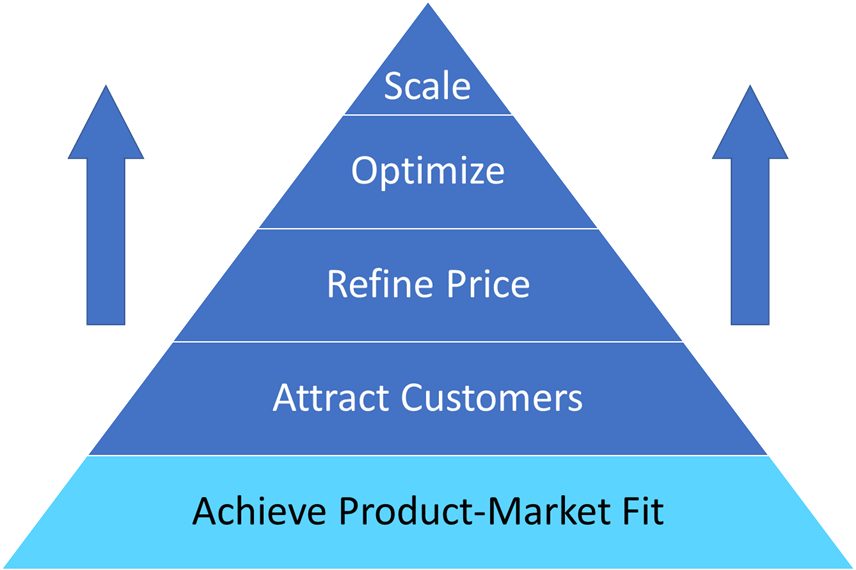Home// Articles// Product & Engineering// How To: Assess Product-Market Fit
How To: Assess Product-Market Fit
 Russ Wilcox
Partner at Pillar VC
Russ Wilcox
Partner at Pillar VC
One of the key goals of early stage companies is to find product-market fit.
This is the stage after product launch where you get feedback and see if all your hard work identifying the right target segments and listening to their feedback paid off — did you build something customers like? If so, congratulations! You’re ready to raise more capital and expand the business.
Immediate success is rare though. An estimated two out of every three new product introductions fail, so it’s typical for a first product to require some kind of adjustment, re-design, or pivot to a different application before product-market fit is achieved.
As the Founder and CEO of Boston software company Bullhorn, Art Papas has brought multiple products to market–some enormously successful, but not all. Art joined us at Pillar last week to lead a workshop for local early-stage CEOs, sharing his experiences, lessons learned, and rules of thumb for achieving product-market fit.
Art graduated from Tufts with a Math B.S. and started his career as a software engineer at Thomson Reuters. He and two co-founders then started Bullhorn, and over 20 years have built it into one of Boston’s most notable software companies, with $200M in sales, 700 employees, 8000 customers and 8 global offices. Bullhorn makes the software that staffing agencies use to manage their customers and contractors. In 2014, Ernst & Young named him an EY Entrepreneur of the Year Award Winner in New England. Art also gives back to the community as Chairman at Career Collaborative, a non-profit that teaches unemployed adults how to build life-changing careers.
For more on Art, see this 2017 Boston Globe profile.

Business-Building Pyramid
Art likes a framework he learned that shows the path to building a business as a pyramid, where a company starts at the bottom and then works its way up.
“After you have achieved product-market fit, then you have something ready to sell, and so the next step is learning how to attract customers. Once your sales group is up, you can run tests to refine the price point and improve unit economics. After the product is priced correctly, you then refine the message and distribution to optimize the LTV to CAC ratio. At that point you have everything in good shape, and your focus shifts to scaling.”
As product-market fit is the foundation, getting it right is critical.
Searching for Product-Market Fit. When Bullhorn started, the idea was to create a two-sided marketplace to connect graphic designers with corporate customers. They had lots of freelancers sign up, but not enough corporations posting projects. It was a business model that would eventually work for others, but at the time corporations just did not have enough awareness of the Web to adopt. One customer said that he could not log on regularly, because the company only had one AOL account and there was a line to use it. “How did we know that product wasn’t working? We met personally with 70 buyers and they still would not post jobs. Sometimes you are just too early.”
They tried to pivot to a related concept — software to manage creative projects — but aimed it at large enterprises, who turned out to be slow adopters. He says in hindsight, the plan might have worked if they had started with small and medium-size businesses (SMBs). Art notes that many early SaaS companies start with SMBs as they are more tolerant of risk.
Art was then introduced by one of his investors to a staffing agency. In stark contrast to the hesitating customers from his first two ideas, here the CEO leaned forward and said his current software for managing job candidates was terrible, and it was a searing pain for him, and “If you can solve this, I will pay and so will everyone in my industry.” Art quickly coded up a working version. Every staffing agency they met also either said they had the pain and were ready to buy now, or they had the pain but did not want to rely on cloud-hosted software (an objection Art felt sure would fade over time).
If you can solve this, I will pay and so will everyone in my industry.
Although they were now on a much better track, that was not obvious at first. Art and his co-founder hotly debated whether to switch to staffing vs. just keep trying harder on the original idea. It was only after they landed the 10th order for the new staffing agency product that they reached consensus to pivot. Once the whole team got over the emotional block of “giving up” on the old product, they aligned powerfully, and Bullhorn landed 100 orders by the end of the first year of selling. That staffing product, designed in response to a paying customer, remains the mainstay of Bullhorn’s current business today.
“When you have a founder who is a skilled salesperson as my co-founder is, and you really do have product-market fit, the results are like wildfire.”
Art’s story shows how a CEO’s determination, ambition, and self-honesty are tested at the product-fit stage. It is all too easy to hope that a lukewarm launch response could be fixed later, perhaps with extra time and money.
😍
Do not fool yourself though — true product-market fit is unmistakable.
Great CEOs set a high bar and keep scouting and testing creatively, until finally they have a product worth scaling.

Four Signs of Product-Market Fit
Art says you do have product-market fit if these criteria are true:
1.
Customers have a clear and burning need.
2.
They are willing to pay a price that is meaningful to them.
3.
They actively buy more and they tell others.
4.
Customers are demanding more features from you and are willing to wait.

Don't Climb a
Wobbly Pyramid
Art described two cases where he tried climbing the pyramid higher before he had firmly established the product-market fit as a foundation. Each time, he ended up wasting time and money.
He had to cancel the product.
“You can’t skip the part where a customer is willing to pay.”
A few years back, the company developed a free tool for easily posting company jobs onto social media sites. The product was downloaded and tried by hundreds of thousands of companies. He became excited to move up the pyramid, and Bullhorn invested millions to drive awareness. Yet the free product did not actually met the Product-Market Fit criteria! When it came time to shift from free to premium, they found no willingness to pay. Posting jobs onto social media was too simple a task for a corporate customer to justify spending money.
Another product they tried was an analytics add-on, for an extra 20% of the base product price. Customers loved the demo! So they went quickly to market, and the sales team started landing orders right away. However, Bullhorn had skipped the criteria for product-market fit where you make sure customers like the product and are telling other customers. It was only after they shipped to a large fraction of the customer base that the company realized the actual user experience was poor. The result was a black eye and a blow to their reputation. “You can’t skip the part where the customers like the product either.”


Questions About
Product-Market Fit
Is it better for a start-up to sell an enhanced product to an existing market, or to enable a whole new market application?
Either can work and it is a matter of preference. Personally, Art prefers the former. When you know a market exists, you take on less risk. Art says “At each point along the journey, my style was to focus just on the steps needed to double the business. Of course, after we did that enough times, we had built a major company. So for me it’s step by step, not wildly swinging for the fences.”
How should I think about product-market fit in a two-sided marketplace?
Art considers that “the customer is the side that is most willing to pay” (the demand side), and so your product development is to do whatever it takes to attract the other side. For example, today LinkedIn has enormous revenue from businesses who want to advertise jobs, however LinkedIn had no way to sell ads to those businesses until after they had spent years attracting a large, live database of professionals via a free networking product. “Sometimes it’s not chicken and egg. It’s just chicken.”
How do I prioritize when customers give inconsistent feedback about the product?
Art suggests first listing out the suggestions, then rating each on how broadly it would help your customer base, and then estimating the effort to implement each one as easy or hard. That makes it simple — start with the features that are both desired by a lot of customers and easier to implement.
Questions About
Being a CEO
What percent of my time should be selling?
Art thinks CEOs definitely should spend regular time with customers. Below $10M in sales, he was involved in negotiating every deal to some extent. Since this is not scalable, now he focuses on larger customers or customers in a new and strategic area where he wants first hand experience. An ideal schedule he likes is Monday is for team meetings, Tuesday for 1:1s and skip-levels, Wed/Thurs for travel and meetings with customers and investors, and Friday for clearing out smaller matters and deeper thinking on longer-range projects.
How should I think about product-market fit in a two-sided marketplace?
Art notes that the higher up the pyramid you get before raising VC money, the lower your ultimate dilution. Bootstrapping in the middle stages, after you have product-market fit, can be a slower way to grow yet can be quite positive, because a tight budget forces you to go through the steps cautiously and rigorously, and because it reduces total dilution.
How did you keep his job as a founder-CEO across so many growth stages and investment rounds?
Art says that even though many founders fear that the investors might try to install a new CEO, in his experience investors really do NOT want to do that. Hiring a CEO means a lot of meetings and interviews, which takes up their time; hiring anyone new is risky; and the new person has less attachment and commitment than a founder and might leave. He says the real key to job security as a founder is “whether you are a learner”. If you are, and you can show you are learning the new systems and skills needed to keep up with growth, and you are making progress each year, then investors will want to stick with you for a long time.


